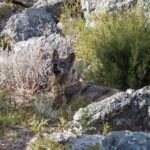Introduction
Overview of the Spanish Wolf
The Spanish wolf, also known as Canis lupus signatus, is a fascinating and elusive creature that inhabits the Iberian Peninsula. With its distinctive appearance and behavior, the Spanish wolf has captured the attention of both researchers and nature enthusiasts. This article serves as the ultimate guide to understanding and hunting the Spanish wolf, providing valuable insights into its habitat, diet, hunting techniques, and conservation efforts. Whether you are an experienced hunter or simply curious about this majestic predator, this guide will equip you with the knowledge and skills necessary to navigate the unique challenges of hunting the Spanish wolf.
Importance of Hunting the Spanish Wolf
Hunting the Spanish Wolf is of great importance for several reasons. Firstly, it helps in maintaining a balanced ecosystem by controlling the population of this apex predator. The Spanish Wolf plays a crucial role in the food chain, and its presence ensures the survival of various species in the region. Additionally, hunting the Spanish Wolf helps in mitigating conflicts between humans and wolves, as it prevents the wolves from encroaching into human settlements and causing damage to livestock. Moreover, hunting the Spanish Wolf provides economic benefits to local communities through tourism and hunting activities, contributing to the sustainable development of the region. Overall, recognizing the importance of hunting the Spanish Wolf is essential for the conservation of both wildlife and human interests.
Purpose of the Guide
The purpose of this guide is to provide comprehensive information and guidance for hunters interested in pursuing the Spanish Wolf. Whether you are a seasoned hunter or a beginner, this guide will equip you with the knowledge and skills necessary to navigate the unique challenges of hunting this elusive and majestic creature. From understanding the behavior and habitat of the Spanish Wolf to mastering effective hunting techniques, this guide aims to empower hunters to engage in responsible and ethical hunting practices. By promoting a deeper understanding and appreciation for the Spanish Wolf, we hope to contribute to its conservation and ensure its long-term survival in the wild.
Understanding the Spanish Wolf
Physical Characteristics
The Spanish wolf, also known as the Iberian wolf, is a majestic creature with distinct physical characteristics. One of the most noticeable features of the Spanish wolf is its size, with males typically weighing between 30 to 50 kilograms, while females are slightly smaller. They have a robust build, with strong muscles and a thick coat of fur that helps them withstand the harsh weather conditions of their natural habitat. The fur of the Spanish wolf can vary in color, ranging from gray to brown, providing them with excellent camouflage in their forested surroundings. Their ears are pointed and upright, allowing them to detect even the slightest sounds, while their sharp teeth and powerful jaws make them formidable predators. Overall, the physical characteristics of the Spanish wolf make it a truly remarkable and awe-inspiring animal.
Habitat and Range
The Spanish wolf, also known as the Iberian wolf, is native to the Iberian Peninsula in southwestern Europe. It primarily inhabits the mountainous regions of Spain and Portugal, including the Picos de Europa, Sierra de la Culebra, and Sierra Nevada. The wolf’s habitat consists of forests, woodlands, and open grasslands, providing it with the necessary cover and prey. Due to its adaptability, the Spanish wolf can also be found in agricultural areas and even near human settlements. However, the population of this magnificent predator has significantly declined over the years due to habitat loss, fragmentation, and human activities. Conservation efforts are crucial to protect and preserve the habitat and range of the Spanish wolf.
Behavior and Social Structure
The behavior and social structure of the Spanish wolf is fascinating and complex. These majestic creatures are known for their highly developed social bonds and hierarchical pack structure. Within a wolf pack, there is a dominant alpha pair that leads and makes decisions for the group. Other pack members, including subordinates and offspring, play important roles in hunting, raising young, and defending the pack’s territory. Communication is crucial in maintaining the social order, with wolves using a variety of vocalizations, body postures, and scent marking. Understanding the behavior and social dynamics of the Spanish wolf is essential for effective conservation and management efforts.
Legal Considerations
Hunting Regulations
Hunting regulations play a crucial role in ensuring the sustainability and conservation of wildlife populations, including the Spanish Wolf. These regulations are designed to manage hunting activities, protect endangered species, and maintain a balance between human interests and the needs of the ecosystem. In Spain, hunting the Spanish Wolf is strictly regulated to ensure its long-term survival. Hunters must obtain the necessary permits and adhere to specific guidelines, such as hunting seasons, bag limits, and ethical hunting practices. By following these regulations, hunters contribute to the preservation of the Spanish Wolf population and promote responsible hunting practices.
Permits and Licenses
Obtaining permits and licenses is an essential step for anyone planning to hunt the Spanish Wolf. In order to legally pursue this majestic creature, hunters must adhere to the regulations set by the local authorities. These regulations vary depending on the region, so it is important to research and understand the specific requirements for the desired hunting location. Typically, hunters will need to obtain a hunting license, which may require completing a hunter education course and passing a written exam. Additionally, a wolf hunting permit may be necessary, which can be obtained through the appropriate wildlife management agency. It is crucial for hunters to ensure they have the necessary permits and licenses before embarking on their hunting expedition, as failure to comply with the regulations can result in severe penalties.
Protected Areas
Protected areas play a crucial role in the conservation of the Spanish wolf. These designated areas provide a safe haven for the wolf population, allowing them to roam freely and thrive in their natural habitat. The establishment of protected areas not only ensures the preservation of the species but also helps maintain the balance of the ecosystem. By safeguarding the Spanish wolf’s habitat, we are not only protecting a magnificent predator but also safeguarding the biodiversity and ecological integrity of the region.
Preparing for the Hunt
Researching the Spanish Wolf
Researching the Spanish Wolf is a crucial step in understanding its behavior, habitat, and population dynamics. To gather accurate information, researchers employ various methods such as field surveys, camera trapping, and genetic analysis. By studying the feeding patterns, territorial range, and social structure of the Spanish Wolf, scientists can gain insights into its ecological role and conservation needs. Additionally, research on the Spanish Wolf helps in identifying potential threats and developing effective management strategies to ensure the long-term survival of this iconic species.
Choosing the Right Gear
When it comes to hunting the Spanish Wolf, choosing the right gear is essential. The harsh terrain and unpredictable weather conditions make it necessary to have equipment that is durable and reliable. A sturdy pair of boots with good traction is a must-have, as you will be navigating through rugged mountainous areas. Additionally, a high-quality rifle with a powerful scope is crucial for accurate shots. It is also important to have proper camouflage clothing to blend in with the surroundings and avoid detection. Lastly, don’t forget essential accessories such as a hunting knife, binoculars, and a backpack to carry all your gear. By selecting the right gear, you will increase your chances of a successful and enjoyable hunting experience.
Physical Fitness and Training
Physical fitness and training play a crucial role in successful wolf hunting. The Spanish Wolf is known for its speed, agility, and endurance, making it a formidable opponent. To effectively track and capture these elusive creatures, hunters must be in peak physical condition. This involves regular cardiovascular exercises, such as running or cycling, to improve stamina and endurance. Additionally, strength training exercises, such as weightlifting or resistance training, are essential for building the necessary muscle power to handle the challenges of wolf hunting. A well-rounded fitness routine also includes flexibility exercises to enhance agility and balance. It is important for hunters to maintain a healthy lifestyle, including a balanced diet and sufficient rest, to ensure they can perform at their best during the demanding pursuit of the Spanish Wolf.
Hunting Techniques
Tracking and Scouting
Tracking and scouting are essential skills for any successful wolf hunter. To effectively hunt the Spanish wolf, one must first understand its behavior and habitat. Tracking involves following the wolf’s footprints, analyzing its droppings, and observing other signs of its presence. Scouting, on the other hand, requires surveying the surrounding area for potential wolf dens or resting spots. By mastering these skills, hunters can increase their chances of locating and ultimately capturing the elusive Spanish wolf.
Calling and Decoying
Calling and decoying are two essential techniques used in hunting the Spanish wolf. When it comes to calling, hunters use various devices such as electronic calls or mouth calls to imitate the sounds of prey or other wolves. This technique is effective in luring the wolf closer, as they are naturally curious and territorial. Decoying, on the other hand, involves using a visual lure, such as a realistic wolf decoy, to attract the attention of the wolf. This technique can be combined with calling to create a more realistic and enticing scenario for the wolf. Both calling and decoying require patience, skill, and knowledge of the wolf’s behavior, making them crucial strategies for successful wolf hunting in Spain.
Ambush and Stalking
When it comes to hunting the Spanish Wolf, one of the most effective techniques is ambush and stalking. This method requires patience, stealth, and a deep understanding of the wolf’s behavior. Hunters must carefully study the wolf’s habitat, tracks, and signs to determine the best locations for setting up an ambush. Once in position, hunters must remain motionless and blend into the surroundings, waiting for the perfect moment to strike. Stalking, on the other hand, involves silently tracking the wolf, keeping a safe distance to avoid detection. This method requires exceptional skill and knowledge of the wolf’s movement patterns. Both ambush and stalking techniques require a high level of dedication, perseverance, and respect for the natural environment.
Ethical Hunting Practices
Respect for Wildlife
Respect for wildlife is an essential aspect of hunting the Spanish Wolf. As hunters, it is our responsibility to understand and appreciate the natural environment in which these magnificent creatures reside. This means adhering to ethical hunting practices, such as following hunting regulations, using fair chase methods, and ensuring the humane treatment of animals. By showing respect for wildlife, we not only contribute to the conservation of the Spanish Wolf population but also foster a deeper connection with nature and promote sustainable hunting practices.
Conservation and Sustainability
Conservation and sustainability are crucial aspects when it comes to hunting the Spanish Wolf. As apex predators, wolves play a vital role in maintaining the balance of ecosystems. Therefore, it is essential to implement sustainable hunting practices that ensure the long-term survival of both the wolf population and the surrounding biodiversity. Conservation efforts should focus on promoting coexistence between humans and wolves, as well as preserving their habitats. By adopting responsible hunting methods and supporting conservation initiatives, we can contribute to the preservation of this magnificent species for future generations.
Humane Harvesting
Humane harvesting is a crucial aspect of hunting the Spanish Wolf. It emphasizes the ethical treatment of these majestic creatures throughout the hunting process. Hunters who practice humane harvesting prioritize the use of techniques that minimize suffering and ensure a quick and clean kill. This approach not only respects the dignity of the animal but also contributes to the conservation efforts of the species. By adhering to strict guidelines and regulations, hunters can play a vital role in maintaining a balanced ecosystem while enjoying the thrill of the hunt.


